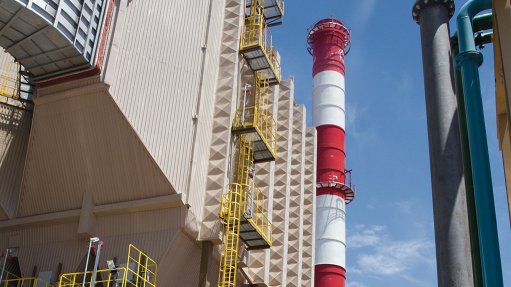
Kalagadi Manganese Sinter Plant
Photo by: Duane Daws
JOHANNESBURG (miningweekly.com) – The railway siding for the Kalagadi Manganese mine near Hotazel, in the Northern Cape, is scheduled for completion in the first quarter (Q1) of 2014.
President Jacob Zuma last Friday launched the sinter plant for Kalagadi Manganese, a black economic-empowerment company headed by Daphne Mashile-Nkosi.
Consulting engineering firm GIBB is the engineering and construction monitoring contractor for the 20 km rail siding, which will be used to rail sinter to a still-to-be-built smelter and for the export, and also to import coking coal for the sinter process.
The 700 000 t of the 2.4-million tons of sinter envisaged for smelting is expected to yield 320 000 t of high-carbon ferromanganese a year.
Manganese fines from neighbouring mines will be used to produce sinter ahead of the commissioning of the mine, Kalagadi Manganese project head George Maluleke told Mining Weekly Online.
The mine, which is 281 m deep, will be commissioned in Q2, along with the crushing and screening plant and the shaft is already fully equipped.
“We’ve actually procured a lot of fines and that’s what we will be sintering and we will be sintering our own ore from Q2,” Maluleke added.
The railway siding has a balloon configuration for rapid sinter loading and includes a linear yard for coke offloading, a yard for shunting and a locomotive maintenance shed.
GIBB technical executive Wimpie Oosthuizen said that to prevent subsidence of the highly collapsible Kalahari sand, excavation, dampening and compaction was carried out and a container used to house the electrical substation.
Calcrete from a neighbouring mine, and discard rock from mining, were the construction materials used.
Had the sinter plant not suffered a transformer failure in September, sinter production would still be under way now.
The transformer is expected to be back in operation by mid-January.
“We already have more than 300 000 t of fines on site, to help us in the ramp-up period, and we are continuing to bring in fines,” Maluleka added.
The plan is to ramp up to 250 000 t a month in 18 months.
“Our manganese and that of our neighbours is from the same geological formation so we are not even talking blending, it is the same type,” he told Mining Weekly Online.